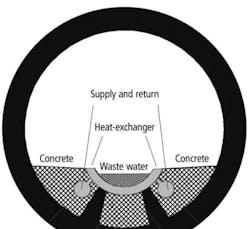Study Examines Automated Demand Response in Wastewater Facilities
By Lisa Thompson, Alex Lekov, Aimee McKane, and Mary Ann Piette
In 2006, the Public Interest Energy Research Program (PIER) Demand Response Research Center (DRRC) at Lawrence Berkeley National Laboratory initiated research into Open Automated Demand Response (OpenADR) applications in California industry. The goal is to improve electric grid reliability and lower electricity use during periods of peak demand.
As displayed in Figure 1, the electricity value chain defines energy management and demand response at six levels of service, distinguished by the magnitude, type, and rapidity of response. One element in the electricity supply chain is OpenADR, an open-standards based communications system to send signals to customers to allow them to manage their electricity demand in response to supply conditions, such as prices or reliability, through a set of standard, open communications.
Initial DRRC research suggests that industrial facilities that have undertaken energy efficiency measures are probably more, not less, likely to initiate other actions within this value chain such as daily load management and demand response. Moreover, OpenADR appears to afford some facilities the opportunity to develop the supporting control structure and to "demo" potential reductions in energy use that can later be applied to either more effective load management or a permanent reduction in use via energy efficiency. Under the right conditions, some types of industrial facilities can shift or shed loads, without any, or minimal disruption to operations, to protect their energy supply reliability and to take advantage of financial incentives.
Municipal wastewater treatment facilities were selected as a focus of the DRRC's OpenADR research because these facilities are energy-intensive and have significant electricity demand during utility peak periods. Additionally, many wastewater treatment facilities have already implemented energy efficiency measures making it more likely for them to participate in other actions in the value chain including OpenADR programs.
In the United States, estimates for energy use in water and wastewater treatment range from 75,000 to 100,000 GWh annually. In the next 10 years, wastewater treatment loads are expected to increase by 20 percent due to the population growth and more stringent regulations. The facility demand required to treat and transport wastewater is significant during peak energy demand periods experienced by electrical utilities.
Further, the majority of wastewater treatment facilities in California have the controls capability to implement OpenADR. The DRRC recently conducted a survey of control capabilities and Open ADR readiness in California's major industries, which revealed that over 80% of wastewater treatment facilities in California have a centralized control system that is capable of controlling all of the facility's major end uses. However, the survey revealed that the majority of these centralized control systems are not connected to the internet, and therefore are not yet able to be fully automated for OpenADR.
Facility Description
The DRRC furthered its research by conducting a submetering study on a municipal wastewater treatment facility in Southern California. The study facility processes an average of 9.5 million gallons per day, and draws between 900–1,100 kW from the grid, using an additional 600–700 kW produced by an onsite cogeneration facility. The cogeneration facility runs on digester gas, a byproduct of the anaerobic digestion process, and has a capacity of 730 kW. The facility manages its operations through the use of a Supervisory Control and Data Acquisition (SCADA) system, and is capable of being fully automated for OpenADR.
Figure 2 shows the average electricity use and hourly load variability from 2009 total facility data, before the cogeneration facility was brought online. The facility load for each 15 minute period is averaged for the entire year and shown in dark blue dots. The maximum and minimum facility load for each time increment is also shown. The band around the average shows one standard deviation of the average facility load. Overall, the facility has little load variability throughout the day.
Results
The submetering project targeted key equipment at the facility, including three effluent pumps, two centrifuges, and two blowers, which account for about 45 percent of the facility's total electricity demand. Seventeen demand response tests were conducted on these three key end-uses which demonstrated the demand response potential of the facility, and illustrated the potential for OpenADR in similar municipal wastewater treatment facilities.
Results of demand response tests on the effluent pumps revealed a maximum load reduction potential of 300 kW, which could be sustained for several hours during peak operations. The centrifuge system was able to provide 40 kW of peak demand savings, and the aeration blowers could further shed 250 kW of peak electricity use. However, the two manual demand response tests on the aeration blowers resulted in short-term increases in effluent turbidity 12 to 24 hours after the tests were conducted, indicating that total solids in the system were high. This research concluded that fully shutting down the blowers may not be a feasible demand response strategy for municipal wastewater treatment facilities.
Figure 3 displays the load reduction potential of the facility. A peak period load reduction of 540 kW was achieved, or 30% of the total facility load.
Conclusion
This submetering study concluded that wastewater treatment facilities are highly energy-intensive and key equipment such as pumps and centrifuges can be targeted for large load reductions. Advanced controls such as SCADA systems may prepare facilities to be more receptive to open automated demand response due to access to real-time data and offering the degree of control integration required for the implementation of OpenADR.
The equipment with the highest demand response potential was the facility's effluent pumps. Wastewater was easily diverted to the facility's effluent storage ponds. Pumping treated effluent to the ocean was simply shifted to off-peak hours. Demand response tests on the effluent pumps revealed an average potential of 204 kW (36 percent of pump load) peak period load reduction, and a 300 kW load reduction for the entire duration of the test.
Tests on centrifuges revealed an average peak period load reduction of 10 kW (30 percent of centrifuge load), and a 40 kW load reduction for the entire duration of the demand response test. While the demand response tests on facility blowers resulted in a short-lived turbidity increase, average peak period load reductions of 78 kW (31 percent of blower load) were seen during these tests.
Although the demand response tests at the facility were successful, the cogeneration capabilities at the facility restrict the plant's demand response potential. Because the facility's cogeneration capacity is such a large proportion of the total load, the facility may have limited options in terms of demand response measures. Further, the degradation in effluent quality due to the blower shutdowns underscores the opportunity for installing variable frequency devices (VFD) on key equipment. For example, installing a VFD on the blower motors would allow the facility to gradually lower aeration blower load, delivering the required amount of oxygen into the aeration basins to maintain effluent quality while reducing facility load. The facility's SCADA system could control the aeration load to ensure facility operations remain within regulated safety limits.
While this research has explored the general feasibility of reducing electric demand in municipal wastewater treatment facilities, additional work is underway from the DRRC to evaluate how fast and how frequently these loads can respond in future ancillary service markets. Initial work by the DRRC in 2009 showed how demand side loads could participate in spinning reserve markets. In addition, further research is needed to understand how best operation practices enhance the impact of demand response activities.
WW
References
McKane, A., I. Rhyne, A. Lekov, L. Thompson, M.A. Piette. Automating Demand Response: The Missing Link in the Electricity Value Chain. In the Proceedings of the 2008 ACEEE Summer Study on Energy Efficiency in Buildings, Pacific Grove, CA, August 17-22, 2008. LBNL-2736E. August 2008
Consortium for Energy Efficiency, National Municipal Water and Wastewater Facility Initiative, 2008. (Last accessed September 19, 2008.)
Environmental Protection Agency, Ensuring a Sustainable Future: An Energy Management Guidebook, Office of Wastewater Management, Editor. 2008.
Natural Resources Defense Council, Energy Down the Drain: The Hidden Costs of California Energy. 2004, Pacific Institute.
Kiliccote S., M.A. Piette, G. Ghatikar, Lawrence Berkeley National Laboratory; E. Koch, D. Hennage, Akuacom; J. Hernandez, A. Chiu, O. Sezgen, Pacific Gas and Electric Company; and J. Goodin, California Independent Systems Operator. Open Automated Demand Response Communications in Demand Response for Wholesale Ancillary Services. In the Proceedings of the Grid-Interop Forum 2009, Denver, CO, November 17-19, 2009. LBNL-2945E. November 2009
About the Authors: Lisa Thompson, Alex Lekov, Aimee Mckane and Mary Ann Piette are researchers in the Demand Response Research Center at the Lawrence Berkeley National Laboratory. As a part of the Industrial Demand Response group, they have been assessing the potential for Open Automated Demand Response in industrial and municipal wastewater treatment facilities since 2008. They have authored several reports on the issue that have served as a base to further the implementation and deployment of demand response programs throughout California's industries. http://drrc.lbl.gov/
More WaterWorld Current Issue Articles
More WaterWorld Archives Issue Articles



